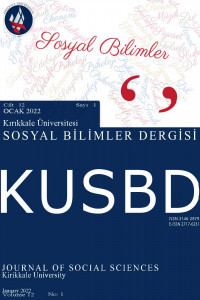ESNEK ÜRETİM SİSTEMLERİ: KAVRAMSAL BİR ÇERÇEVE
Artan küresel rekabet ve yeni teknolojik gelişmeler, firmaları yeni stratejiler aramaya ve geliştirmeye yöneltmektedir. Bu nedenle, üretim rekabetçi stratejik silah olarak kabul edilmektedir. Esnek üretim sistemleri (FMS), firmalara sağladığı esneklikleri nedeniyle yirminci yüzyılın sonlarında giderek artan bir şekilde popüler hale gelmiştir. Bu esneklik, firmaların piyasa değişikliklerine hızlı bir şekilde yanıt vermelerini ve özellikle belirsiz pazarlarda rekabet avantajı elde etmelerini sağlamaktadır.Bu çalışma, firmaların değerlendirme sürecinde FMS'nin geliştirilmesi ve planlanması için temel bir çerçeve sunmaktadır. FMS'nin tanımı ve yapısı, esneklik türleri, FMS problemleri ve modelleme araçları sunulmaktadır.
Anahtar Kelimeler:
Üretim stratejileri, Esnek üretim sistemleri, Esneklik
FLEXIBLE MANUFACTURING SYSTEMS: A CONCEPTUAL FRAMEWORK
Increasing global competition and new technological developments have forced firms to seek and develop new strategies. Thus, the manufacturing has been recognized as a competitive strategic weapon. Flexible manufacturing systems (FMS) has become increasingly popular in the late twentieth century due to flexibility of these systems. Such flexibility enables firms to respond market changes quickly and to get competitive advantage in particularly uncertain markets.This paper provides a fundamental framework for development and planning of FMS in the evaluation process of firms. Definition and structure of FMS, types of flexibility, FMS problems and relative modelling tools are briefly presented.
___
- Buzacott, J.A. and Shanthikumar J.G. (1993), Stochastic Models of Manufacturing Systems, Prentice-Hall, Inc., Englewood Cliffs, New Jersey
- Gerwin, D. (1993), “Manufacturing Flexibility: A Strategic Perspective”, Management Science, 39(4), 395-410
- Groover, M.P. (2015), Automation, Production Systems, and Computer-Integrated Manufacturing, Pearson Higher Education, Inc., New Jersey
- Gupta, Y.P. and Goyal, S. (1989), “Flexibility of Manufacturing Systems: Concepts and Measurements”, European Journal of Operational Research, 43(2), 119-135
- Hayes, R.H. and Pisano, G.P. (1994), “Beyond World-Class - The New Manufacturing Strategy”, Harvard Business Review, Jan-Feb, 72(1), 77-86
- Jaikumar, R. (1986), “Postindustrial Manufacturing”, Harvard Business Review, Nov-Dec, 64(6), 69-76
- Kaighobadi, M. and Venkatesh, K. (1994), “Flexible Manufacturing Systems: An Overview”, International Journal of Operations & Production Management, 14(4), 26-49
- Khan, M.K., Hussain, I. and Noor, S. (2011), “A Knowledge Based Methodology for Planning and Designing of a Flexible Manufacturing System (FMS)”, International Journal of Advanced Manufacturing Systems, 13(1), 95-109
- Kusiak, A. (1985), “Flexible Manufacturing Systems: A Structural Approach”, International Journal of Production Research, 23(6), 1057-1073
- Leong, G.K., Snyder, D.L. and Ward, P.T. (1990), “Research in the Process and Content of Manufacturing Strategy”, OMEGA-International Journal of Management Science, 18(2), 109-122
- Lin, G.C.I. and Nagalingam, S.V. (1999), CIM-Justification and Optimisation, London: Taylor & Francis
- Manu, G., Vijay Kumar, M., Nagesh, H., Jagadeesh, D and Gowtham, M.B. (2018), “Flexible Manufacturing Systems (FMS): A Review”, International Journal of Mechanical and Production Engineering Research and Development (IJMPERD), 8(2), 323-336
- Maslen, R. and Platts, K.W. (1997), “Manufacturing Vision and Competitiveness”, Integrated Manufacturing Systems, 8(5), 313-322
- Meredith, J.B. and Suresh N.C. (1986), “Justification Techniques for Advanced Manufacturing Technologies”, International Journal of Production Research, 24(5), 1043-1058
- Meredith, J.R. and Hill, M.M. (1987), “Justifying New Manufacturing Systems: A Managerial Approach”, Sloan Management, Summer, 28(4), 49-61
- Molenda, P., Drews, T., Oechsle, O., Butzer, S., Schoetz, S. and Steinhilper, R. (2017), “A Simulation-Based Framework for the Economic Evaluation of Flexible Manufacturing Systems”, Procedia CIRP, Manufacturing Systems 4.0 - Proceedings of the 50th CIRP Conference on Manufacturing Systems, 63, 201-206
- Papadopoulos, H.T., Heavey, C. and Browne J. (1993), Queueing Theory in Manufacturing Systems Analysis and Design, Chapman & Hall, London
- Slack, N., Chambers, S., Harland, C., Harrison, A., and Johnston, R. (1998), Operations Management, Financial Times Pitman Publishing, London
- Small, M.H. (1999), “Assessing Manufacturing Performance: An Advanced Manufacturing Technology Portfolio Perspective”, Industrial Management & Data Systems, 99(6), 266-277
- Stecke, K.E. (1985), “Design, Planning, Scheduling, and Control Problems of Flexible Manufacturing Systems”, Annals of Operations Research, 3, 3-12
- Viswanadham, N. and Narahari, Y. (1992), Performance Modelling of Automated Manufacturing Systems, Prentice-Hall, Inc., New Jersey
- Yadav, A. and Jayswal, S.C. (2018), “Modelling of Flexible Manufacturing System: A Review”, International Journal of Production Research, 56(7), 2464-2487
- ISSN: 2146-2879
- Başlangıç: 2011
- Yayıncı: Kırıkkale Üniversitesi
Sayıdaki Diğer Makaleler
Sinan GÜRCÜOĞLU, Fatih ÖZDEMİR
K-ORTALAMALAR YÖNTEMİ İLE BANKALARIN SERMAYE YETERLİLİK RASYOLARINA GÖRE KÜMELENMESİ
ESNEK ÜRETİM SİSTEMLERİ: KAVRAMSAL BİR ÇERÇEVE
MUTAVVEL SARF-I ‘OSMÂNÎ HAKKINDA BİR DEĞERLENDİRME
TÜRKİYE’DE ÇEVRESEL ETMENLER, YOKSULLUK VE ÇOCUK SUÇLULUĞU HARİTALAMA
AVRUPA’NIN DEĞİŞİMİ KARŞISINDA OSMANLI İMPARATORLUĞU VE MİLLİ BURJUVAZİYE GİDEN SÜREÇ
